Research and Perspectives on Fire-Fighting Systems in Tunnels under Strong Piston Wind Action
Abstract
:1. Introduction
1.1. Current Status of Tunnel Development
1.2. Piston Wind Formation
1.3. Tunnel Fire Hazards
1.4. Research Content
- Lack of experimental studies and 3D simulations of special tunnels or multi-motor train tunnels. Most of the current tunnel experiments and simulations have been carried out in the absence of trains or in the case of single-motion trains. Experimental studies of tunnels with dual-motion trains based on absolute motion are one of the most important ways to explore the flow field of tunnels with dual-motion trains. It is important to study the flow field of multi-motor trains in tunnels.
- It is essential to study and understand the flow patterns and their influencing factors for two trains running in a tunnel at the same time. Piston winds play an important role in tunnel ventilation, environment, energy consumption, and disaster prevention, while the piston wind law for multi-motion trains operating in tunnels is significantly different from that for single trains, and there is a lack of relevant research. Taking two trains as an example, a study of piston wind patterns and influencing factors is carried out to compare with the tunnel piston wind patterns of single-motion trains and to extend to the tunnel multi-motion train situation, providing a basis for the study of tunnel multi-motion train flow fields.
- The impact of piston winds on the tunnel environment and ventilation energy consumption still needs to be studied in more depth. The use of piston winds can improve the tunnel environment and reduce the energy consumption of mechanical ventilation in tunnels. Therefore, the use of piston winds needs to be studied in depth, and the effect of piston winds on the application of tunnels in different climatic zones needs to be analyzed quantitatively so that tunnels in different regions can make rational use of piston winds to improve their air quality and save energy consumption in mechanical ventilation.
- There is a lack of research on multi-motor train fires in tunnels. The complex piston effect makes it more difficult to control a fire if there are two trains traveling in the same direction in the same tunnel, and the non-fire train will also have an important impact on the fire train. Therefore, there is an urgent need to carry out research on the smoke flow in the event of a fire in a tunnel with a dual motion train, the critical wind speed and critical wind pressure, etc., to provide basic research on fire prevention and disaster prevention in tunnels.
2. Current Status of Research
2.1. Current Status of Tunnel Piston Wind Research
2.2. Current Status of Tunnel Fire Research
2.3. Fire Prevention and Control in Tunnels
3. Conclusions and Outlook
3.1. Conclusions
- The current research mainly focuses on the piston wind generated when trains pass or cross in subway tunnels and single-shaft railway tunnels. Some scholars have also studied the piston wind effect generated when trains run in double-shaft railway tunnels. However, few scholars have studied the piston wind flow law and wind speed calculation in the tunnel and auxiliary passage when the train runs in the railway tunnel with multiple shafts, multiple rescue cross passages and multiple pressure buffer passages. Meanwhile, it can be seen from the analysis of the research results that the calculation formula of the piston wind theory under different conditions can only calculate the wind speed of the train section but cannot obtain the analysis of the airflow velocity in the whole tunnel and the auxiliary channel. The numerical simulation using CFD software can only obtain the analysis of the airflow field in the whole tunnel when the train is running. It is not possible to calculate the specific piston air volume in each section of the tunnel and auxiliary tunnel.
- On the basis of the total parameter model of the piston wind set and considering the influence of longitudinal ventilation, a model of critical wind pressure and wind speed for tunnel motion train fires should be established to prevent the phenomenon of smoke backflow in tunnel motion train fires through the coupling of mechanical ventilation and piston wind from tunnel dual motion trains. The influence of six factors, namely fire power, train length, tunnel length, train speed, train deceleration, and obstruction ratio, on the critical wind pressure and critical wind speed is analyzed.
- The longitudinal slope of the tunnel, the shape of the section, the curvature of the line and the altitude of the tunnel are characteristics of the tunnel itself and, relatively speaking, these four factors can be called “established factors”. When designing a tunnel for fire and rescue, these four factors should be taken into account and their influence on the critical wind speed should be obtained as accurately as possible. In addition, there is a large gap between the size of the evacuees and the actual passenger flow, and there are still shortcomings in obtaining the evacuation routes for large flows of passengers in the event of a fire, as well as a lack of parameters to support the development and optimization of emergency plans for the behavior of groups evacuating from a fire.
- In terms of tunnel fire testing methods, the current focus is on individual testing of smoke parameters in some of the station smoke protection zones, tunnels, and trains. For large hub stations with complex structures, there are still problems with the density of test points, the comprehensiveness of parameter types, and the lack of synergy in testing multiple smoke protection zones, and there is a lack of experimental tools for the simultaneous and integrated testing of stations, tunnels, and running trains in the fire linkage mode.
3.2. Outlook
- Develop a model for the spread of combustion of typical materials applicable to different flame retardant grades and master the method of predicting fire development in metro tunnels.
- To establish a full scenario element fire test technique for the underground tunnel operation system, to propose a test error analysis and control method, and to master the theoretical system for building a full-scale experimental scenario close to the real fire scene environment.
- In view of the dynamic operating environment of the metro system during a fire, the fire dynamics parameter testing techniques applicable to train operation, sudden changes in tunnel airflow, and cooperative actions of stations and tunnels are proposed, and multi-channel data acquisition for fire tests are integrated under the effect of multiple disturbances, such as electromagnetic fields, thermal fields, high temperatures, and high humidity.
- For smoke control in complex tunnel works, the smoke flow pattern in case of fire in complex tunnel works is mastered.
- Big data-based research on the behavior of tunnel fire personnel. The techniques of survey research and data mining should be fully utilized in this field to obtain the real behavior and psychological activities of tunnel fire personnel to support the strategy of tunnel evacuation and the design of disaster prevention and mitigation facilities.
Author Contributions
Funding
Data Availability Statement
Acknowledgments
Conflicts of Interest
References
- Cai, H.B.; Liu, Z.; Li, S.; Zheng, T.L. Improved analytical prediction of ground frost heave during tunnel construction using artificial ground freezing technique. Tunn. Undergr. Space Technol. 2019, 92, 103050. [Google Scholar] [CrossRef]
- Zhou, Z.; Chen, Y.; Liu, Z.Z.; Miao, L.W. Theoretical prediction model for deformations caused by construction of new tunnels undercrossing existing tunnels based on the equivalent layered method. Comput. Geotech. 2020, 123, 103565. [Google Scholar] [CrossRef]
- Li, W.H.; Liu, T.; Martinez-Vazquez, P.; Xia, Y.T.; Chen, Z.W.; Guo, Z.J. Aerodynamic effects on a railway tunnel with partially changed cross-sectional area. J. Cent. South Univ. 2022, 29, 2589–2604. [Google Scholar] [CrossRef]
- Saito, S. Optimizing cross-sectional area of tunnel entrance hood for high speed rail. J. Wind Eng. Ind. Aerodyn. 2019, 184, 296–304. [Google Scholar] [CrossRef]
- Wang, T.T.; Wu, F.; Yang, M.Z.; Ji, P.; Qian, B.S. Reduction of pressure transients of high-speed train passing through a tunnel by cross-section increase. J. Wind Eng. Ind. Aerodyn. 2018, 183, 235–242. [Google Scholar] [CrossRef]
- Kozo, F.; Takanobu, O. Aerodynamics of high speed trains passing by each other. Comput. Fluids 1995, 24, 897–908. [Google Scholar]
- Ji, Q.N.; Yang, S.; Qiu, J.Y.; Cao, X.L.; Yuan, Y.P. Aerodynamics of railway train/tunnel system: A review of recent research. Energy Built Environ. 2020, 1, 351–375. [Google Scholar]
- Tokuzo, M.; Masanobu, I.; Takashi, F.; Takakage, A. Nondimensional maximum pressure gradient of tunnel compression waves generated by offset running axisymmetric trains. J. Wind Eng. Ind. Aerodyn. 2016, 157, 23–35. [Google Scholar]
- Graf, W.H.; Suszka, L. Unsteady flow and its effect on sediment transport. In Proceedings of the 21st IAHR Congress, Melbourne, Australia, 19–23 August 1985; pp. 1–5. [Google Scholar]
- Graf, W.H.; Qu, Z. Flood hydrographs in open channels. Proc. Inst. Civ. Eng.-Water Manag. 2004, 157, 45–52. [Google Scholar] [CrossRef]
- Nezu, I. Open-channel flow turbulence and its research prospect in the 21st century. J. Hydraul. Eng. 2005, 131, 229–246. [Google Scholar] [CrossRef]
- Bombar, G.; Elçi, Ş.; Tayfur, G.; Güney, M.Ș.; Bor, A. Experimental and Numerical Investigation of Bed-Load Transport under Unsteady Flows. J. Hydraul. Eng. 2011, 137, 1276–1282. [Google Scholar] [CrossRef]
- Chang, L.; Mao, H.Z.; Cong, L.S.; Pei, H.Z.; Xiang, L.T. Temperature profile of fire-induced smoke in node area of a full-scale mine shaft tunnel under natural ventilation. Appl. Therm. Eng. 2017, 110, 382–389. [Google Scholar]
- Nayak, U.S.L.; Gralewski, Z.A.; Stevens, S.J. The aerodynamic drag of tube vehicles traveling at low subsonic speeds. In Proceedings of the 2th ISAVVT, Cambridge, UK, 23–25 March 1976; BHRA Fluid Engineering, Paper El. pp. 1–22. [Google Scholar]
- Gawthorpe, R.G.; Pope, C.W.; Green, R.H. Analysis of train drag in various configurations of a long tunnel. In Proceedings of the 3th ISAVVT, Sheffield, UK, 19–21 March 1979; BHRA Fluid Engineering, Paper G1. pp. 257–280. [Google Scholar]
- Valense, J.; Favier, D.; Magallon, D. Theoretical and experimental investigation of the piston effect in a twin tunnel. In Proceedings of the 2th ISAVVT, Cambridge, UK, 23–25 March 1976; BHRA Fluid Engineering, Paper E3. pp. 57–79. [Google Scholar]
- You, B.H.; Yan, F.L.; Jun, M.L.; Jia, X.L.; Ke, W.; Kai, Z.; Hai, H.L. Experimental investigation on maximum gas temperature beneath the ceiling in a branched tunnel fire. Int. J. Therm. Sci. 2019, 145, 105997. [Google Scholar]
- Yasushi, O.; Graham, T.A. Control of smoke flow in tunnels fires. Fire Saf. J. 1995, 25, 305–322. [Google Scholar]
- Rezatofighi, H.; Tsoi, N.; Gwak, J.Y.; Amir, S.; Ian, R.; Silvio, S. Generalized intersection over union: A metric and a loss for bounding box regression. In Proceedings of the IEEE/CVF Conference on Computer Vision and Pattern Recognition, Long Beach, CA, USA, 15–20 June 2019; pp. 658–666. [Google Scholar]
- Li, Y.Z.; Ingason, H. Editorial: Tunnel fire safety. Fire Saf. J. 2018, 97, 85–86. [Google Scholar] [CrossRef]
- Li, Y.Z.; Ingason, H. Overview of research on fire safety in underground road and railway tunnels. Tunn. Undergr. Space Technol. 2018, 81, 568–589. [Google Scholar] [CrossRef]
- Roh, J.S.; Ryou, H.S.; Kim, D.H.; Jung, W.S.; Jang, Y.J. Critical velocity and burning rate in pool fire during longitudinal ventilation. Tunn. Undergr. Space Technol. 2007, 22, 262–271. [Google Scholar] [CrossRef]
- Li, Y.Z.; Ingason, H. Effect of cross section on critical velocity in longitudinally ventilated tunnel fires. Fire Saf. J. 2017, 91, 303–311. [Google Scholar] [CrossRef]
- Lei, P.; Chen, C.K.; Zhang, Y.L.; Xu, T.; Sun, H.K. Experimental study on temperature profile in a branched tunnel fire under natural ventilation considering different fire locations. Int. J. Therm. Sci. 2021, 159, 106631. [Google Scholar] [CrossRef]
- Liu, M.Z.; Zhu, C.G.; Zhang, H.; Zheng, W.D.; You, S.J.; Campana, P.E.; Yan, J.Y. The environment and energy consumption of a subway tunnel by the influence of piston wind. Appl. Energy 2019, 246, 11–23. [Google Scholar] [CrossRef]
- Liu, M.Z.; Jiang, L.F.; Zhang, H.; Zheng, X.J.; You, S.J.; Wei, S. An exploration on the applicability of heating tower heat pump and air source heat pump systems in different climatic regions. J. Clean. Prod. 2019, 238, 117889. [Google Scholar] [CrossRef]
- Masanori, F.; Seiyu, F.; De, F.C. Determination and simulation of piston winds for metro trains. Tunn. Rail Transit 1988, 35–45. [Google Scholar]
- Niu, J.Q.; Zhou, D.; Liang, X.F.; Liu, T.H.; Liu, S. Numerical study on the aerodynamic pressure of a metro train running between two adjacent platforms. Tunn. Undergr. Space Technol. 2017, 65, 187–199. [Google Scholar] [CrossRef]
- Ming, T.K.; Tsung, C.C.; Wen, P.W. Numerical simulation for optimizing the design of subway environmental control system. Build. Environ. 2002, 37, 1139–1152. [Google Scholar]
- Zhu, F.; Yu, Z.X.; Cao, R.Z.; Liu, Z.X. Time Variant Characteristics of Piston Wind for Billboards Affiliated with Subway Tunnels. J. Southwest Jiaotong Univ. 2018, 53, 1048–1057. [Google Scholar]
- Blom, F.J. Considerations on the spring analogy. Int. J. Numer. Methods Fluids 2015, 32, 647–668. [Google Scholar] [CrossRef]
- Iga Shin, I. An equatorially enhanced grid with smooth resolution distribution generated by a spring dynamics method. J. Comput. Phys. 2017, 330, 794–809. [Google Scholar]
- Jia, M.W.; Allen, T.C. A hydrodynamic model of a two-part underwater towed system. Ocean Eng. 2000, 27, 455–472. [Google Scholar]
- Bertoluzza, S.; Chabannes, V.; Prud’Homme, C.; Szopos, M. Boundary conditions involving pressure for the Stokes problem and applications in computational hemodynamics. Comput. Methods Appl. Mech. Eng. 2017, 322, 58–80. [Google Scholar] [CrossRef]
- Shuai, S.D.; Huo, Y.D. Analysis of a stabilized finite element method for Stokes equations of velocity boundary condition and of pressure boundary condition. J. Comput. Appl. Math. 2018, 337, 290–318. [Google Scholar]
- Zarnaghsh, A.; Abouali, O.; Emdad, H.; Goodarz, A. A numerical study of the train-induced unsteady airflow in a tunnel and its effects on the performance of jet fans. J. Wind Eng. Ind. Aerodyn. 2019, 187, 1–14. [Google Scholar] [CrossRef]
- Quintiere, J.G. Scaling applications in fire research. Fire Saf. J. 1989, 15, 3–29. [Google Scholar] [CrossRef]
- Li, Y.Z.; Ingason, H. Discussions on critical velocity and critical Froude number for smoke control in tunnels with longitudinal ventilation. Fire Saf. J. 2018, 99, 22–26. [Google Scholar] [CrossRef]
- Zhang, H.; Zhu, C.G.; Liu, M.Z.; Zheng, W.D.; You, S.J.; Li, B.J.; Xue, P. Mathematical modeling and sensitive analysis of the train-induced unsteady airflow in subway tunnel. J. Wind Eng. Ind. Aerodyn. 2017, 171, 67–78. [Google Scholar] [CrossRef]
- Zhang, H.; Cui, T.; Liu, M.Z.; Zheng, W.D.; Zhu, C.G.; You, S.J.; Zhang, Y.Z. Energy performance investigation of an innovative environmental control system in subway station. Build. Environ. 2017, 126, 68–81. [Google Scholar] [CrossRef]
- Huang, Y.D.; Gao, W.; Kim, C.N. A numerical study of the train-induced unsteady airflow in a subway tunnel with natural ventilation ducts using the dynamic layering method. J. Hydrodyn. Ser. B 2010, 22, 164–172. [Google Scholar] [CrossRef]
- Wang, S.G.; Zhu, Y.X.; Jiang, Y. Actual measurement and analysis of heat flow at wall surfaces in the Beijing underground thermal environment. Tunn. Rail Transit 1997, 3, 32–37. [Google Scholar]
- Chu, C.R.; Chien, S.Y.; Wang, C.Y.; Wu, T.R. Numerical simulation of two trains intersecting in a tunnel. Tunn. Undergr. Space Technol. 2014, 42, 161–174. [Google Scholar] [CrossRef]
- Liu, M.Z. Investigation of the Piston Wind Induced by Multiple Trains and Model Simplification in Ultra-Long Tunnel. Ph.D. Thesis, Tianjin University, Tianjin, China, 2020. [Google Scholar] [CrossRef]
- Hua, X.W.; Zi, H.G.; Jie, J.; Jun, F.; Yong, M.Z. Experimental study on horizontal gas temperature distribution of two propane diffusion flames impinging on an unconfined ceiling. Int. J. Therm. Sci. 2019, 136, 1–8. [Google Scholar]
- Wan, H.X. Interaction Behaviors of Two Symmetrical Square Fires under Different Confined Conditions. Ph.D. Thesis, University of Science and Technology of China, Hefei, China, 2018; pp. 97–112. [Google Scholar]
- Hans, N.; Haukur, I. Temperature stratification in tunnels. Fire Saf. J. 2011, 48, 30–37. [Google Scholar]
- Hua, X.W.; Zi, H.G.; Jie, J.; Kai, Y.L.; Jin, H.S.; Yong, M.Z. Experimental study on ceiling gas temperature and flame performances of two buoyancy-controlled propane burners located in a tunnel. Appl. Energy 2017, 185, 573–581. [Google Scholar]
- Gannouni, S.; Madd, R.B. Numerical study of the effect of blockage on critical velocity and backlayering length in longitudinally ventilated tunnel fires. Tunn. Undergr. Space Technology. 2015, 48, 147–155. [Google Scholar] [CrossRef]
- Liu, Q.; Zheng, F. Study on variation rules of critical ventilation velocity for double-source tunnel fires. J. Disaster Prev. Mitig. Eng. 2018, 38, 137–143. [Google Scholar]
- Cui, X.Y.; Zhao, J.L.; Yao, Y.Z.; Yuan, S.S.; Wu, B.; Huang, H. Numerical simulation on double fire source tunnel. J. Cent. South Univ. (Sci. Technol.) 2022, 53, 2255–2267. [Google Scholar]
- Delichatsios, M.A. A correlation for the flame height in “group” fires. Fire Sci. Technol. 2007, 26, 1–8. [Google Scholar] [CrossRef]
- Weng, W.; Kamikawa, D.; Hasemi, Y. Experimental study on merged flame characteristics from multifire sources with wood cribs. Proc. Combust. Inst. 2015, 35, 2597–2606. [Google Scholar] [CrossRef]
- Chen, C.K.; Nie, Y.L.; Zhang, Y.L.; Lei, P.; Fan, C.G.; Wang, Z.Y. Experimental investigation on the influence of ramp slope on fire behaviors in a bifurcated tunnel. Tunn. Undergr. Space Technol. 2020, 104, 103522. [Google Scholar] [CrossRef]
- Liu, N.; Zhang, S.; Luo, X.; Lei, J.; Chen, H.X.; Xie, X.D.; Zhang, L.H.; Tu, R. Interaction of two parallel rectangular fires. Proc. Combust. Inst. 2019, 37, 3833–3841. [Google Scholar] [CrossRef]
- Zhang, Y.C.; Xing, S.S.; Chen, R.J.; Chen, L.F.; Li, T.; Mao, P.F. Experimental study on maximum temperature beneath tunnel ceiling under the condition of double fire sources. Tunn. Undergr. Space Technol. Inc. Trenchless Technol. Res. 2020, 106, 103624. [Google Scholar] [CrossRef]
- Qiang, W.; Shao, M.W.; Huan, L.; Jia, Y.S.; Feng, J.S.; Cong, L.S.; Fei, T. Characterization of ceiling smoke temperature profile and maximum temperature rise induced by double fires in a natural ventilation tunnel. Tunn. Undergr. Space Technol. Inc. Trenchless Technol. Res. 2020, 96, 103233. [Google Scholar]
- Yi, L.; Xu, Q.; Xu, Z.; Wu, D.X. An experimental study on critical velocity in sloping tunnel with longitudinal ventilation under fire. Tunn. Undergr. Space Technol. 2014, 43, 198–203. [Google Scholar] [CrossRef]
- Li, Y.; Ingason, H. Influence of fire suppression on combustion products in tunnel fires. Fire Saf. J. 2018, 97, 96–110. [Google Scholar] [CrossRef]
- Cong, L.S.; Wei, L.; Wen, J.H.; Mao, H.Z.; Xing, K.Z. A modified thermal radiation model with multiple factors for investigating temperature rise around pool fire. J. Hazard. Mater. 2019, 379, 120801. [Google Scholar]
- Both, C.; Haar, P.; Tan, G.L.; Wolsink, G.M. Evaluation of passive fire protection measures for concrete tunnel linings. In Proceedings of the International Conference & One Day Seminar ‘Tunnel Fires and Escape from Tunnels’, Lyon, France, 5–7 May 1999. [Google Scholar]
- Wang, Y.F.; Yan, F.P. Research on the Maximum Smoke Temperature around the Vault of a Tunnel on Fire. China Saf. Sci. J. (CSSJ) 2007, 17, 39–44. [Google Scholar]
- Hua, G.Y.; Wang, W.; Zhao, Y.H.; Li, L.; Xiao, J. Discussion on Fire Protection Design of Urban Traffic Link Tunnel. Build. Sci. 2008, 24, 4. [Google Scholar]
- Wang, W.; Yan, S.; Liu, J. Studies on temperature induced creep in high strength Q460 steel. Mater. Struct. 2017, 50, 1–14. [Google Scholar] [CrossRef]
- Chirasmita, P.; Mrinmoy, M.; Sankha, K.; Hari, N.M.; Sirshendu, D. Shelf life extension of sugarcane juice by cross flow hollow fibre ultrafiltration. J. Food Eng. 2020, 274, 109880. [Google Scholar]
- Jun, J.C.; Pei, Z.N.; Guang, F.X.; Teng, D. Data fusion method based on recursive least square and improved support for WSN. Meas. Control Technol. 2019, 38, 65–68+74. [Google Scholar] [CrossRef]
- He, X.; Wang, T.; Liu, W.; Luo, T. Measurement data fusion based on optimized weighted least-squares algorithm for multi-target tracking. IEEE Access 2019, 7, 13901–13916. [Google Scholar] [CrossRef]
- Wang, K.; Liu, G.; Tao, Q.; Zhai, M. Efficient Parameters Estimation Method for the Separable Nonlinear Least Squares Problem. Complexity 2020, 2020, 1–16. [Google Scholar] [CrossRef]
- Cigada, A.; Ruggieri, D.; Zappa, E. Road and railway tunnel fire hazard: A new measurement method for risk assessment and improvement of transit safety. In Proceedings of the 2005 IEEE International Workshop on Measurement Systems for Homeland Security, Contraband Detection and Personal Safety Workshop, 2005. (IMS 2005), Orlando, FL, USA, 29–30 March 2005; pp. 89–94. [Google Scholar] [CrossRef]
- Parida, B.K.; Carter, J.; Zaouk, A.K.; Punwani, J. Assessment of Fire Hazards and Mitigation Methods in Locomotive Fuel Tanks. In Proceedings of the ASME 2011 Rail Transportation Division Fall Technical Conference, Minneapolis, MN, USA, 21–22 September 2011; pp. 77–86. [Google Scholar] [CrossRef]
- Elsayed, T.; Lehrta, H.; Belhaj, I. Fuzzy inference system for fire and explosion risk assessment of floating storage and offloading vessels. Proc. Inst. Mech. Eng. Part M J. Eng. Marit. Environ. 2011, 225, 171–180. [Google Scholar] [CrossRef]
- Jančaříková, E.; Mikolaj, J.; Danišovič, P. Risk and Incidents Assessment in Slovak Road Tunnels. Procedia Eng. 2017, 192, 376–380. [Google Scholar] [CrossRef]
- Seike, M.; Kawabata, N.; Hasegawa, M. Quantitative assessment method for road tunnel fire safety: Development of an evacuation simulation method using CFD-derived smoke behavior. Saf. Sci. 2017, 94, 116–127. [Google Scholar] [CrossRef]


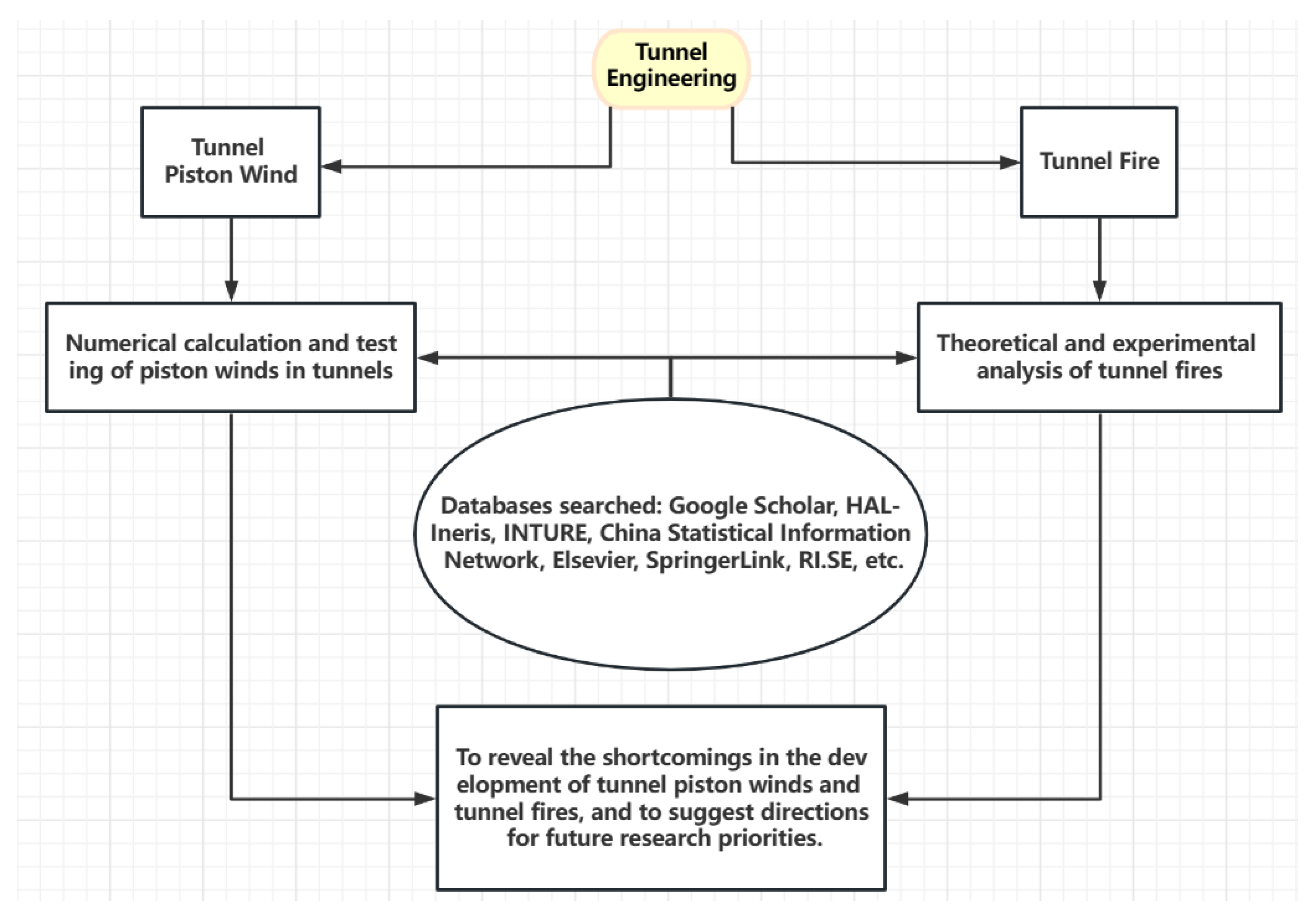


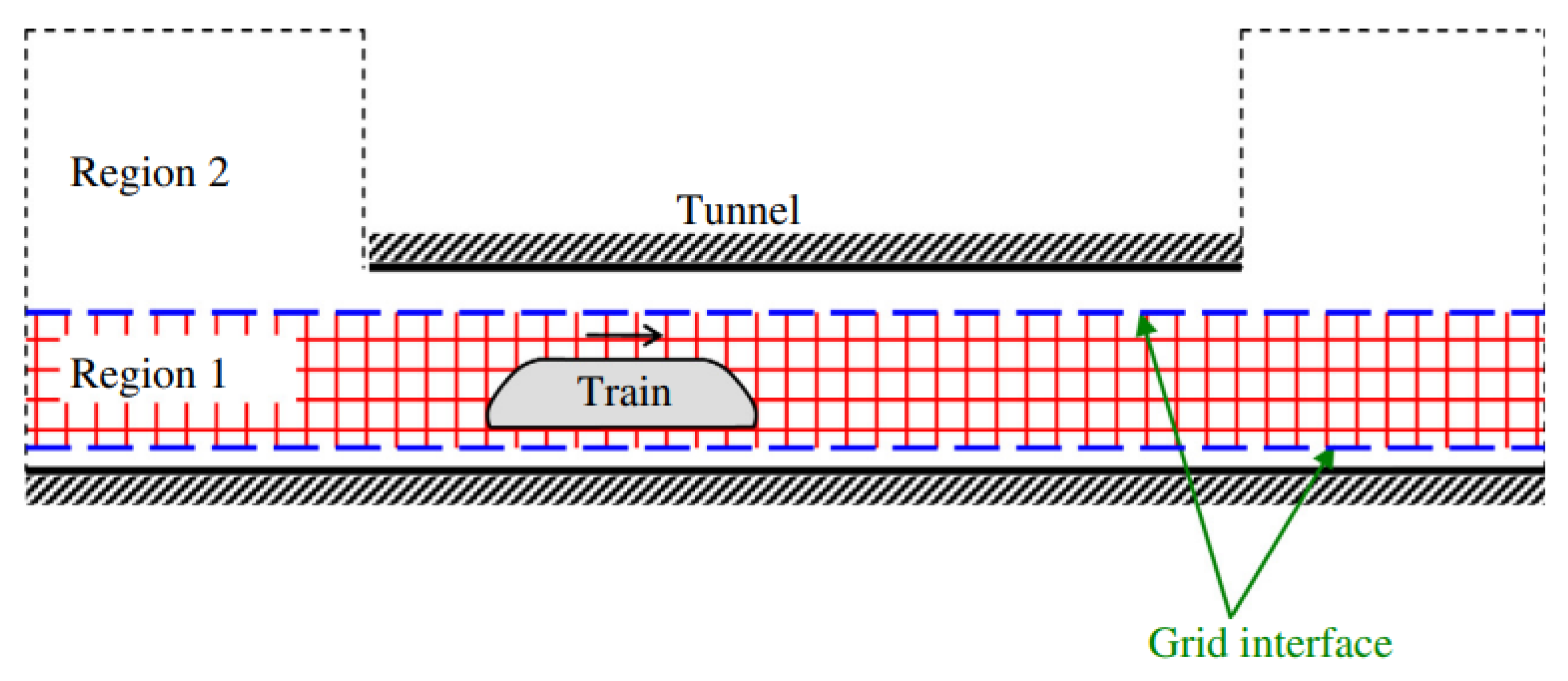

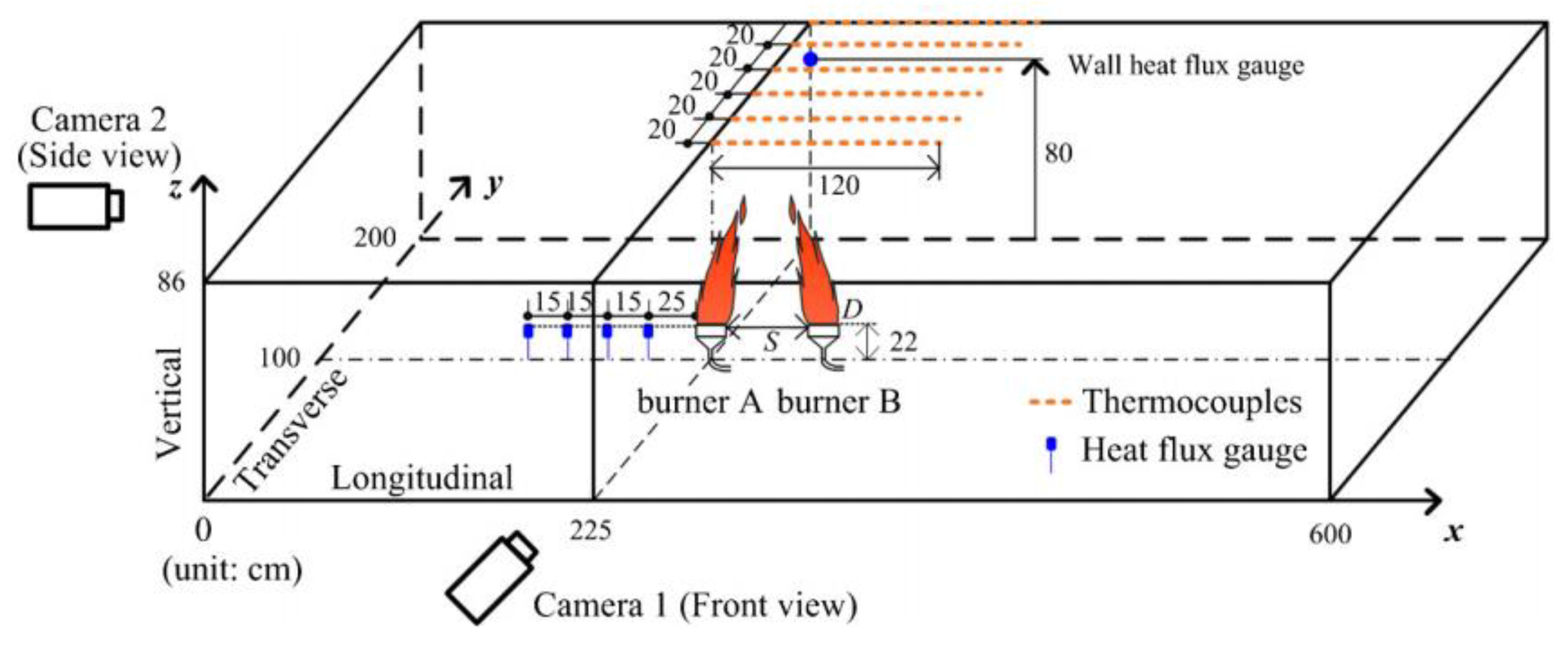



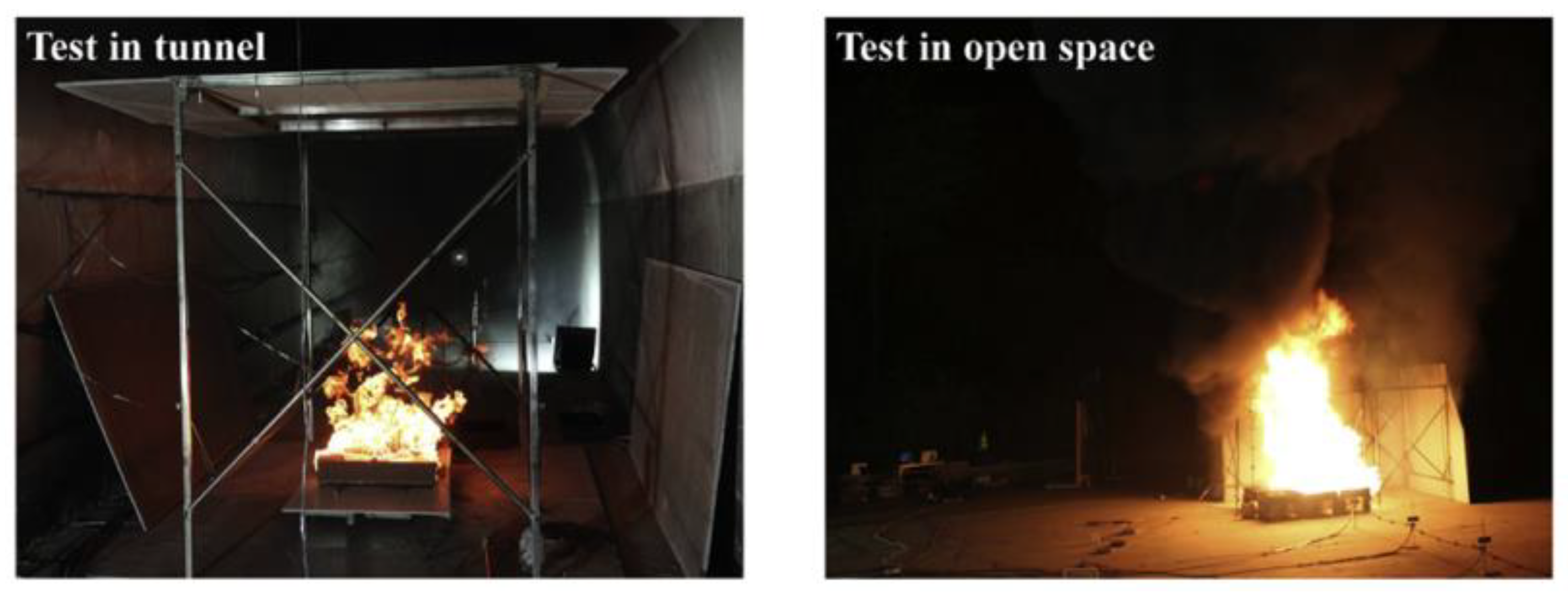

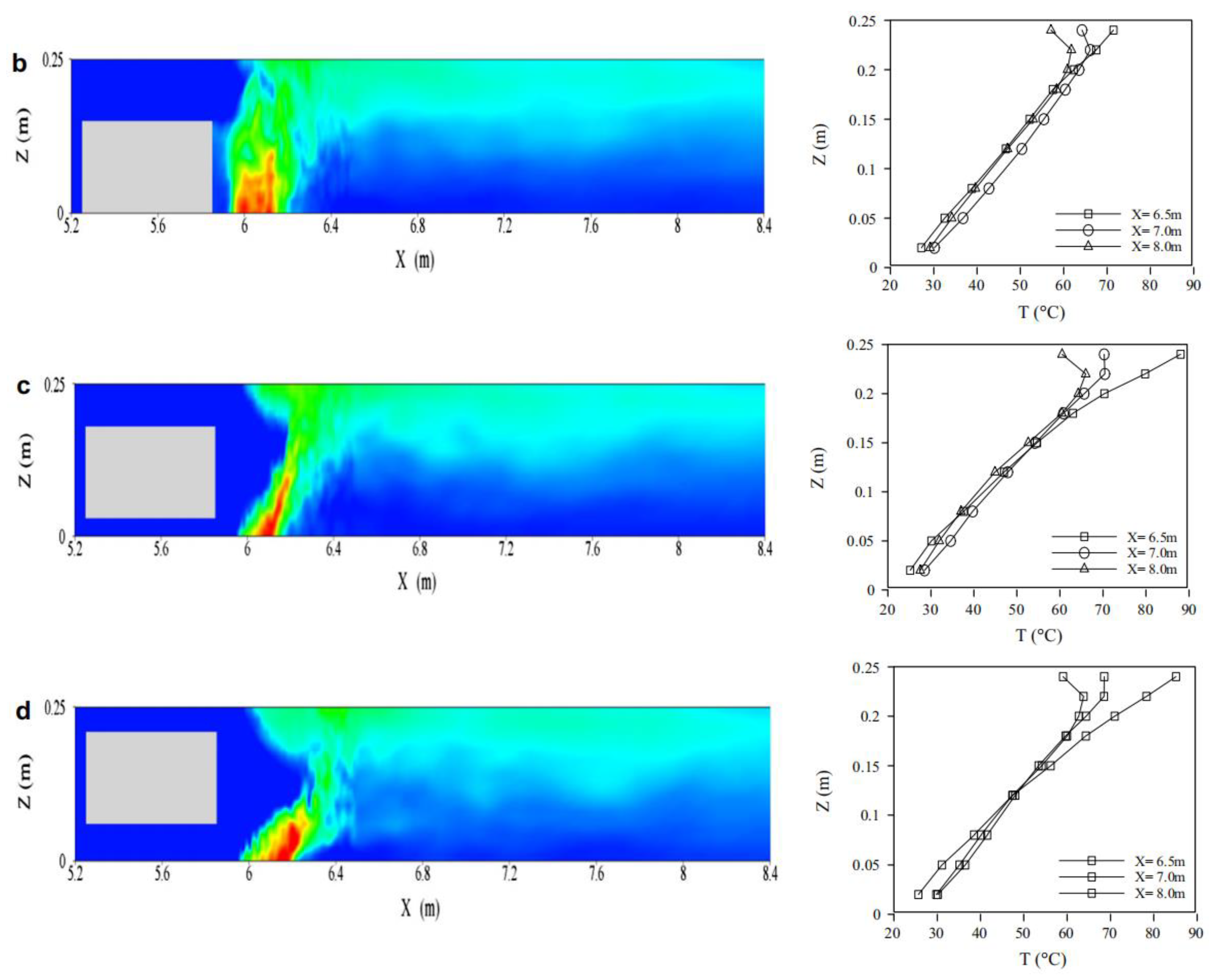
| Time | Location of the Accident | Casualty | Damage | The Cause of the Accident |
|---|---|---|---|---|
| 1971 | Klotz Tunnel, France | 3 dead | The burning tank continued to burn overnight, causing part of the tunnel to collapse | Oil tank train explodes and catches fire |
| 1972 | Hokuriku Tunnel, Japan | 30 dead, 714 injured | The smoking room, steward’s room, dining room, kitchen equipment and flooring in the fire area were all burnt down | Train dining car fire |
| 1976 | Baishuijiang 140# Tunnel on the Baocheng Line, China | 75 dead, 9 injured | 620 tonnes of oil burned up | Cargo train derails, overturns, causes tank train explosion |
| 1996 | Anglo-French Cross-Harbour Tunnel | 36 injured | Six trucks burned and 11 trucks were damaged along with the locomotive | Car fire |
| 2000 | Kitzsteinhorn Mountain Tunnel, Austria | 155 dead, 18 injured | The train was damaged, with heavy casualties | Train fire |
| 2005 | France-Italy T2 Fureyres Tunnel | 2 dead, 21 people suffering from excessive smoke inhalation | 4 trucks burnt, 3 fire engines damaged, severe damage to tunnel leading to closure | Diesel spills |
| 2006 | Vimala Tunnel on the A13 in Switzerland | 6 dead, 6 injured | 1 bus, 2 cars burnt | Car rear-end |
| 2007 | US Interstate 5 Tunnel | 3 dead, 10 injured | Serious damage to the tunnel structure | 16 vehicles caught fire in a series of collisions |
| 2008 | Guangdong Dabao Mountain Tunnel | 2 dead | Vehicle burnt out, concrete reinforcement falling off tunnel roof, closed for 1 month for repairs | Xylene spill burning |
| 2010 | Wuxi Huishan Tunnel | 24 dead, 19 injured | Bus burned down | Passenger car spontaneous combustion |
| 2014 | Yan Hou Tunnel, Jincheng Section of Jinji Expressway, Shanxi | 40 dead, 12 injured | 42 vehicles burnt and concrete dislodged from 3 parts of the tunnel | Methanol truck rear-ends, causing vehicle fire |
Disclaimer/Publisher’s Note: The statements, opinions and data contained in all publications are solely those of the individual author(s) and contributor(s) and not of MDPI and/or the editor(s). MDPI and/or the editor(s) disclaim responsibility for any injury to people or property resulting from any ideas, methods, instructions or products referred to in the content. |
© 2023 by the authors. Licensee MDPI, Basel, Switzerland. This article is an open access article distributed under the terms and conditions of the Creative Commons Attribution (CC BY) license (https://creativecommons.org/licenses/by/4.0/).
Share and Cite
Zhao, X.; Shu, Z.; Pei, X. Research and Perspectives on Fire-Fighting Systems in Tunnels under Strong Piston Wind Action. Buildings 2023, 13, 435. https://doi.org/10.3390/buildings13020435
Zhao X, Shu Z, Pei X. Research and Perspectives on Fire-Fighting Systems in Tunnels under Strong Piston Wind Action. Buildings. 2023; 13(2):435. https://doi.org/10.3390/buildings13020435
Chicago/Turabian StyleZhao, Xiaoyi, Zhile Shu, and Xiangjun Pei. 2023. "Research and Perspectives on Fire-Fighting Systems in Tunnels under Strong Piston Wind Action" Buildings 13, no. 2: 435. https://doi.org/10.3390/buildings13020435





